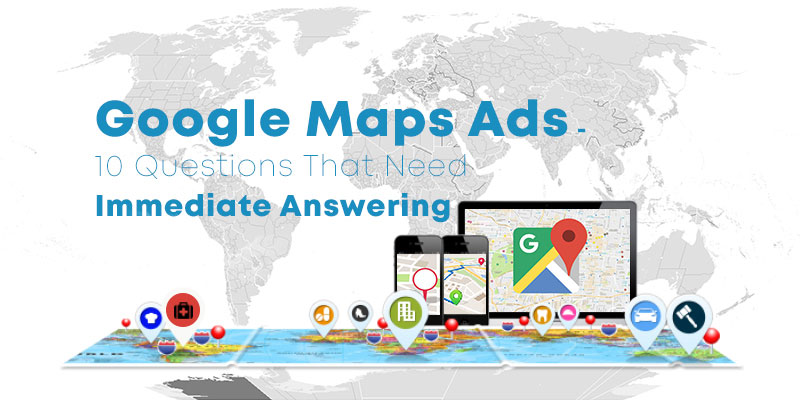I hope you enjoy reading this blog post.
If you want to get more traffic, Contact Us

Click Here - Free 30-Minute Strategy Session
Be quick! FREE spots are almost gone for this Month. Free Quote

In 2023, Google Maps Ads hold significant value for businesses aiming to enhance their local presence. With mobile searches increasing and “near me” queries surging, these ads act as a powerful tool to connect businesses with nearby customers. They allow companies to appear prominently in search results, boosting visibility and engagement.
Key benefits include:

Click Here – Free 30-Minute Strategy Session
Be quick! FREE spots are almost gone for this Month
Increased Foot Traffic: Ads attract users actively seeking nearby services or products.
Targeted Reach: Location-based targeting ensures a highly relevant audience.
Pinpoint Information: Potential customers can view details such as operating hours, reviews, and directions effortlessly.
Google Maps Ads amplify local marketing, making them indispensable for competitive growth in dynamic markets.
To achieve success with Google Maps Ads, businesses should focus on implementing a set of proven core principles. These underpin an effective advertising strategy, ensuring visibility and engagement with local audiences.
Optimise Google My Business (GMB): Maintaining an up-to-date GMB profile with accurate details, such as contact information, operating hours, and customer reviews, is fundamental. This builds trust and boosts ranking.
Target Localised Keywords: Incorporate relevant, location-specific keywords to align ads with user search intent and improve ad relevance scores.
Leverage Extensions: Use call, location, and sitelink extensions to provide users with one-click options for essential actions like calling or navigating to a business.
Monitor Campaign Performance: Regularly track ad metrics such as click-through rates (CTR) and conversions. Adjust bids and wording to optimise ROI.
Adhering to these principles ensures targeted, streamlined advertising success.
To maximise visibility, businesses must focus on fully optimising their Google My Business (GMB) profile. A complete and accurate profile increases trust and enhances search rankings. Key optimisation tactics include:
Providing Comprehensive Information: Ensure all fields—business name, address, contact number, website, hours—are correctly filled.
Using High-Quality Media: Upload professional photos and videos to drive engagement.
Leveraging Keywords: Incorporate targeted keywords in business descriptions for improved search placements.
Enabling Customer Reviews: Encourage reviews and actively respond to feedback to boost credibility.
Utilising Regular Updates: Regularly post updates, events, and offers to maintain relevance and attract customers.
These efforts, combined with active management, ensure top-tier visibility on Google Maps and search results.
Geo-targeting allows advertisers to refine their audience by focusing on specific locations. This strategy ensures Google Maps ads reach users in areas most likely to engage with the business.
Define Clear Boundaries: Use radius targeting around business locations to attract nearby customers.
Target Multiple Locations: Consider targeting high-traffic zones or competitor areas to gain visibility.
Adapt to Seasonal Demand: Adjust locations based on events or seasonal trends impacting user behaviour.
Utilise Demographics: Pair geo-targeting with insights into age, gender, and income for tailored campaigns.
Exclude Irrelevant Areas: Prevent ad spend on locations with minimal relevance using exclusion settings.
Optimising Google Maps ads requires harnessing the power of location-specific keywords tailored to the business’s geographical area. These keywords help target users actively searching for relevant services or products nearby. By understanding local terminology and trends, advertisers can refine their approach to match consumer behaviour.
Research Local Search Terms: Identifying phrases frequently used by the local audience ensures relevance. For instance, “best coffee in Birmingham” targets specific intent.
Include Area Names in Keywords: Adding city, neighbourhood, or region terms enhances search ranking.
Monitor Competitors: Analysing competitors’ keyword use unveils valuable insights for keyword strategies.
Businesses should consistently update these keywords to align with dynamic local trends and seasonal changes.
Effective ad copy is essential for drawing attention and driving action in Google Maps Ads. Businesses must craft concise, targeted text that resonates with local searchers. Engaging headlines should highlight key selling points, such as proximity, special offers, or unique services. Calls-to-action must be clear and actionable, urging users to visit, call, or explore further.
To optimise conversions, ad copy should incorporate relevant keywords tied to user intent, such as “nearby,” “local,” or specific service terms. Including social proof, like reviews or accolades, enhances credibility. Regularly testing variations ensures consistent refinement for maximum click-through rates.
Reviews and ratings play a pivotal role in influencing consumer decisions on Google Maps. Leveraging positive feedback allows businesses to build credibility and trust, which can directly impact ad success. Higher ratings make ads more appealing, encouraging users to click through.
Businesses should ensure reviews are prominently displayed alongside their ads. This can create a sense of authenticity and reliability. Actively requesting feedback from customers helps maintain a steady stream of reviews.
Additionally, monitoring customer sentiment through reviews can guide campaign adjustment strategies. Keywords from positive reviews can be integrated into ad copy, enhancing relevance and effectiveness. Responding to reviews demonstrates engagement and commitment, completing the trust-building process.
Ad extensions play a pivotal role in increasing the visibility and appeal of Google Maps ads. These powerful tools provide advertisers with an opportunity to add layers of information beyond the basic ad text. Among the commonly utilised extensions are call extensions, location extensions, and site link extensions, all of which serve specific purposes.
Call Extensions: Enable users to connect directly with businesses via phone, streamlining customer interactions.
Location Extensions: Display physical addresses prominently, making it easier for local customers to find businesses.
Site Link Extensions: Direct users to specific pages, offering tailored solutions based on their needs.
Leveraging these extensions ensures clearer communication and encourages action through well-crafted, actionable messages.
Tracking key metrics is essential for optimising Google Maps ad campaigns. Advertisers should regularly monitor click-through rates (CTR), impressions, and conversion rates to understand campaign effectiveness. Google Ads’ reporting tools allow detailed insights into user interactions, including search queries, location data, and engagement patterns.
To refine campaign strategies, users can experiment with A/B testing. This involves comparing ad variations to determine which creatives or keywords drive better results. Additionally, focusing on metrics like cost per click (CPC) and return on investment (ROI) helps identify potential budget adjustments.
Regular evaluation empowers advertisers to spot inefficiencies, improve targeting accuracy, and ultimately maximise ad performance on Google Maps.
Businesses often make errors that prevent Google Maps ads from achieving optimal performance. One major mistake is neglecting to update location data accurately. Outdated or incorrect addresses can confuse users and reduce trust in the business. Failing to optimise the Google Business Profile is another common oversight; missing hours, categories, or relevant information can limit engagement.
Overspending on broader targeting without analysing customer behaviour can also harm return on investment. Advertisers should avoid ignoring negative keywords, which can prevent ads from appearing for irrelevant searches. Regular monitoring of metrics such as clicks and conversions ensures campaigns perform effectively.
To excel in local advertising, businesses must adapt to evolving technologies and consumer behaviours. Voice search continues to grow, highlighting the need for optimised, conversational keywords in Google Maps Ads. The rise of AI-driven data analysis enables advertisers to target specific demographics more effectively. Additionally, integrating Augmented Reality (AR) features for richer user experiences is gaining momentum.
Keeping an agile approach is key. Embracing sustainability messaging and personalisation strengthens brand loyalty locally. As hyperlocal targeting becomes more sophisticated, businesses can target smaller radiuses with tailored campaigns. Monitoring competitor strategies through analytics tools is vital to staying front-footed in the market.
Optimise Google My Business Profile Ensure the business listing is complete, accurate, and updated with engaging photos, contact details, and operational hours. A robust profile strengthens credibility.
Set Precise Targeting for Ads Configure ad targeting based on proximity to the business location, demographic preferences, and user behaviour to attract high-quality leads.
Integrate Location Extensions Activate location extensions in Google Ads to display address, clickable phone number, and directions, enhancing local reach and convenience for users.
Leverage Local Keywords Optimise ad campaigns with geo-targeted keywords that align with local search trends, prioritising context over broad phrases.
Utilise Call-to-Actions (CTAs) Craft compelling CTAs like “Visit Us Today” or “Get Directions Now” to guide users directly to the location through Google Maps.
Mobile-Friendly Content Ensure ad creatives, landing pages, and business listings are responsive for mobile users, who dominate Google Maps searches.
Track Performance Metrics Monitor metrics like clicks, impressions, and conversions using Google Ads reports, identifying opportunities to refine strategies.

LEAVE A REPLY